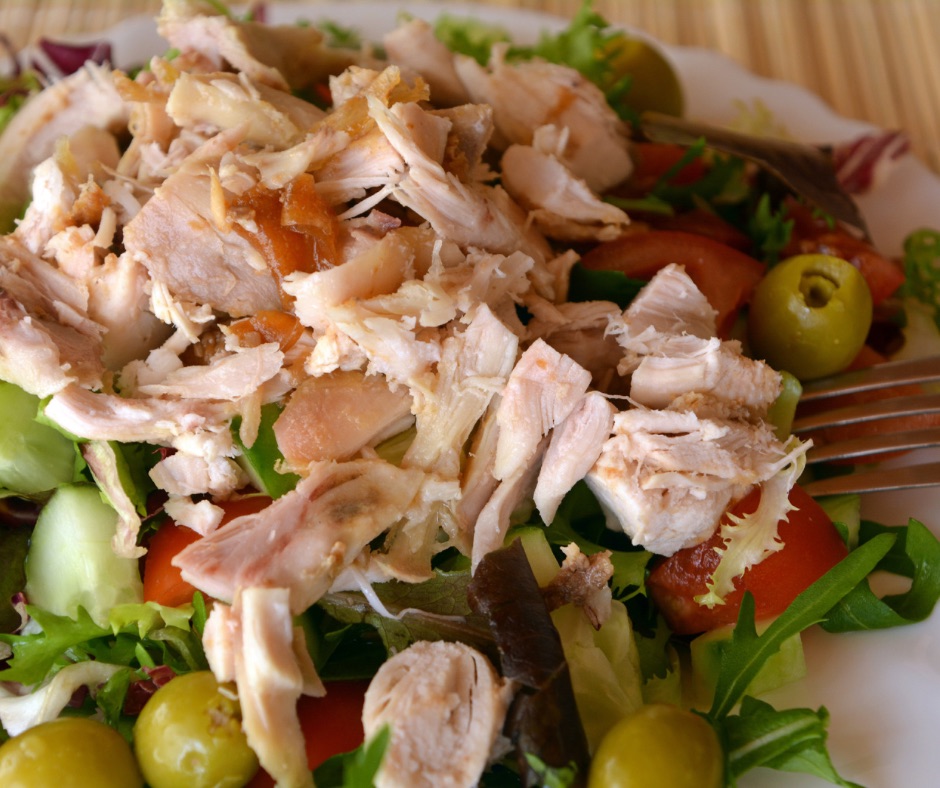Moo Goo Gai Pan and Chicken with Mixed Vegetables are two popular dishes that are often ordered at restaurants.
Both dishes are made with chicken and vegetables, but there are some key differences between them.
In this article, we will take a closer look at both dishes and compare them side-by-side.
We will discuss the ingredients, and the key things that sets them apart.

Moo Goo Gai Pan Vs Chicken with Mixed Vegetables
Moo Goo Gai Pan, a Cantonese phrase signifying ‘chicken and mushrooms’, is a dish that is essentially formed of sliced or cubed chicken alongside white button mushrooms served in a light white sauce.
Named after its prime ingredients, this dish brings together the gentle flavors of chicken broth, soy sauce, oyster sauce, rice wine, sesame oil and cornstarch that create its defining sauce.
On the other hand, we have the humble Chicken with Mixed Vegetables.
A generic name cloaking a medley of diverse vegetables like carrots, bok choy, snow peas, bamboo shoots, water chestnuts and cabbage.
The flavors bend to a broader spectrum here – owing to the range and proportions of vegetables used along with different sauces and seasonings that come into play.
While both dishes may be Americanized interpretations of Chinese cuisine, they hold separate roots – Moo Goo Gai Pan is an American spin-off of traditional Cantonese fare originating from southern China while Chicken with Mixed Vegetables is influenced by various regional styles including Sichuan or Hunan.
What Is In Moo Goo Gai Pan Chicken?
When you order a plate of Moo Goo Gai Pan at your favorite Chinese restaurant, what are you really getting?
Well, at its core, Moo Goo Gai Pan features thinly sliced boneless, skinless chicken breast. Then white button mushrooms that are sliced and stir-fried along with the chicken, lending their earthy notes to the mix.
The party doesn’t stop there: a medley of other vegetables including carrots, snow peas, bamboo shoots and water chestnuts join in to make this dish an excellent source of various nutrients and fiber.
These veggies contribute vibrant color and a delightful crunch that keeps every bite interesting.
The real star of Moo Goo Gai Pan could be arguably the sauce —an aromatic mix of oyster sauce for umami depth, soy sauce for salty balance; cornstarch as a thickening agent providing that glossy finish; and chicken broth as base which ties everything together.
This sauce is what takes humble chicken and mushrooms from good to great.
Why Is It Called Moo Goo Gai Pan?
For a fun food fact – “Moo Goo Gai Pan” is not just a random assortment of syllables but, in fact, depicts its main components and origin.
Moo Goo Gai Pan is actually a transliteration from the Cantonese phrase “moh gu gai pin”, which simply means “chicken and mushrooms”.
The dish stays true to its name, featuring slices of chicken and white button mushrooms as its primary ingredients.
To further delve into the etymology, each part of ‘Moo Goo Gai Pan’ refers to a significant ingredient in this delightful medley. ‘Moo goo’ stands for mushrooms while ‘gai’ represents chicken.
Finally, ‘pan’ signifies slices or sliced ingredients which refers to how both the chicken and mushrooms are prepared.
What Is The History Of Moo Goo Gai Pan?
Moo Goo Gai Pan has a rich historical narrative that dates back to the 1800s.
This era saw abundant Chinese immigration to the U.S., with many hailing from Guangdong province’s southwestern corner, known as Canton in those times.
Among these immigrants was a significant population from the Taishan or Toisan region.
Interestingly, this area boasts its own distinct language – Taishanese – which, while related to Cantonese, presents stark differences in tones and pronunciation.
Thus, the English rendition of ‘moo goo gai pan’, many believe is rooted in Taishanese dialect rather than Cantonese.
The birth of American-Chinese cuisine primarily found its basis in the culinary traditions carried by these Taishanese immigrants around the 1800s.
Amidst this fusion of flavors and cultures emerged Moo Goo Gai Pan, eventually positioning itself as one of the most popular offerings in American-Chinese restaurants.
Its popularity spiked notably mid-20th century as Americans developed a growing fascination for Chinese food.
However, like any immigrant story has its adaptation phase, so did Moo Goo Gai Pan undergo certain modifications catering to the local palate and ingredient accessibility in America.
The once light sauce morphed into a heartier version with additions like soy sauce, oyster sauce, rice wine and cornstarch giving it greater depth and flavor.
Similarly, variety graced its vegetable constituents as broccoli, carrots snow peas bamboo shoots and water chestnuts found their way into this dish adding not just vibrant color but also texture variance.
What Is The Difference Between Moo Shu Chicken and Moo Goo Gai Pan?
Starting with ingredients and presentation, Moo Shu Chicken is a roll-up of shredded chicken, cabbage, wood ear mushrooms, scallions, and eggs swathed in a sweet and savory sauce.
The twist?
It’s traditionally served with thin Mandarin pancakes used for wrapping around the hearty filling before being dipped in Hoisin sauce.
Conversely, Moo Goo Gai Pan is a stir-fry starring sliced chicken, white button mushrooms and assorted vegetables like carrots, snow peas water chestnuts, bamboo shoots all cooked in a light white sauce.
It’s typically presented as a main course dish accompanied by rice or noodles or even part of an elaborate multi-course meal.
Now onto origins – the roots of these dishes lie far apart in China’s culinary map.
Moo Shu Chicken hails from northern China with strong ties to Beijing and Shandong provinces.
This dish is essentially an adaptation of the traditional moo shu pork – ‘moo shu’ translating to “wood shaving” in Mandarin reflects the shape of utilized wood ear mushrooms.
As for Moo Goo Gai Pan, it finds its origins in southern China specifically the Canton region though what we see today is an Americanized rendition of this dish known originally as moh gu gai pin which quite literally means “chicken and mushrooms”.
Moo Goo Gai Pan vs Chop Suey
Chop Suey, a term translating to ‘mixed pieces’ in Cantonese, is a delightful mix of different types of meat including chicken, beef, pork or shrimp along with an array of vegetables such as celery, bean sprouts, cabbage, and onions all stirred together in a thick brown sauce.
In contrast, Moo Goo Gai Pan strictly features chicken as its principal protein accompained by white button mushrooms – so quintessential that it’s part of the name!
This dish is complemented by other vegetables like carrots, snow peas water chestnuts and bamboo shoots all basking in a light white sauce.
Does Moo Goo Gai Pan Have A Lot Of Salt?
According to nutritional data, a single cup (216 g) of Moo Goo Gai Pan contains roughly 477 mg of sodium.
This accounts for approximately 21% of your recommended daily intake.
It’s important to note that the majority of this comes from the sauce used in the dish.
However, fear not!
If you’re striving for a low-sodium meal, consider ordering your sauce on the side or even asking for less sauce to be used.
In addition, despite its sodium content, Moo Goo Gai Pan stands tall as one of the healthier options when opting for Chinese takeout.
It boasts low levels of fat and sugar, yet delivers high on protein and fiber – not to mention a medley of vitamins, minerals and antioxidants offered by its variety of vegetables.
Seeking more low-sodium alternatives in Chinese cuisine?
You can explore options such as steamed dumplings or spring rolls; chicken with broccoli or mixed vegetables; tofu dishes; brown rice or noodles; or perhaps a bowl of hot and sour soup or wonton soup.
However, caution should be exercised with dishes that are fried, crispy breaded or drenched in thick sauces – these are likely loaded with sodium fat and calories.
Some examples include egg rolls or fried wontons; General Tso’s chicken or orange chicken; sweet and sour pork or chicken; Lo mein or chow mein; egg drop soup or hot and sour soup.

